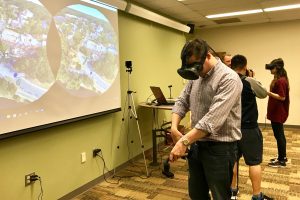Fall 2018 Immersive Technology Wrap-Up
Summary
In collaboration with the TLC (Technology Learning Center), this past semester we expanded the scope of the Immersive Technology Initiative to increase access to our VR/AR tools. TLC students now can assist faculty, staff and students in our HTC Vive room during their daily open hours (found here). This added capacity has greatly increased the ways our community can experiment with these new technologies. We are very excited to be working with the TLC and look forward to continued collaboration.
This past fall we helped support a number of learning activities utilizing immersive technologies spanning the sciences, humanities, and first year seminars. Particularly exciting for me was Dr. Eugene Wu’s Structural Biology 3D modeling project. Dr. Wu asked his students to create a presentation on a biological structure and/or mechanism using 3D visualization tools. To complete the assignment, students utilized both the TLC’s 3D printing capability and molecular visualization software, Nanome, using the HTC Vive.
Below are all the courses that held Immersive Technology workshops in the fall. In addition to those course workshops, we also held 3 faculty-focused workshops. Together with the TLC, we hosted 9 workshops that exposed 112 students and faculty to the latest virtual and augmented reality technologies. If you are interested in using VR/AR technologies in your classroom and research program, please reach out to me at abell4@richmond.edu.
Courses Workshops
- PSYCH 333 Cognitive Science Dr. Beth Crawford
- FYS 101 The Search for the Self Prof. Marcia Whitehead
- FYS 101 The Neuroscience of Photography Dr. Andrew Bell
- RHCS 105 Media, Culture, and Identity Dr. Lauren Tilton
- BIO 335 Structural Biology Dr. Eugene Wu
VR Spaces
- Gottwald Science Reading Room (HTC Vive Pro)
- Boatwright RM 321 (HTC Vive Pro)
- Mobile Immersive Set (HTC Vive, can be set up anywhere within < 1 hr)
Equipment
- 2x HTC Vive
- 2x HTC Vive Pro
- 20 Google Cardboard (Mattel Viewfinder version)
- 1 Google Daydream (Lenovo Mirage)
- 1 Ricoh Theta 360 camera
- 15 ARKit-enabled iPads
Comments closed
